Katsu Kaishu
The Man Who Saved Early Modern Japan
By Romulus Hillsborough
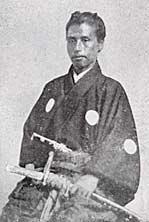 |
Katsu Kaishu in San Francisco,
1860
|
Editor's Note: This is the second article on Japanese Samurai
leaders who, at the end of Japan’s
feudal period, defied death and personal safety to help forge a new Japan.
The first article was “Sakamoto
Ryoma: The Indispensable “Nobody.”
The unexpected arrival in 1853 of a squadron of heavily armed black
navel ships into the bay of the Shogun’s capital, Edo (now Tokyo),
sent shock waves through Japanese society. Commodore Perry, the head
of the US navel force, presented demands for Japan to open its ports
to the outside world. Feeling impotent in the face of superior western
technology and military power, competing feudal military domains quickly
took sides and fought over which strategy to take to defeat the foreign
menace. Japan had long lingered in isolation, united under a system of
Samurai dominated domains held together by military might, with a central
Shougunate power in Edo (now Tokyo). At the same time people also gave
allegiance to the Emperor in Kyoto. From amongst the turmoil and infighting,
Katsu Kaishu emerged as a decisive leader. His worldview, foresight,
support of certain leaders, such as Sakamoto Ryoma, diplomacy and his
political astuteness, helped Japan emerge from feudalism into unified
modern state. It was a truly miraculous transformation. Almost overnight
feudalism had ended. Gone too were social classes, including the dominate
Samurai military class. Centuries of competing Samurai fiefdoms had been
replaced, and people saw themselves as part of a larger entity, Japan
as a nation. Japan too avoided the fate of so many other Asian countries,
such as China and India, which had become subjugated and turned into
European economic enclaves.
Article: Katsu Kaishu, “consummate samurai, streetwise denizen of Downtown
Edo, founder of the Japanese navy, statesman par excellence and always
the outsider, historian and prolific writer, faithful retainer of the
Tokugawa Shogun and mentor of men who would overthrow him,” was
among the most remarkable of the numerous heroes of the Meiji Restoration.
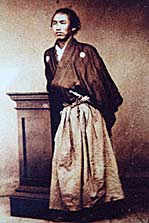 |
Sakamoto Ryoma
|
Kaishu’s protégée was Sakamoto Ryoma, a key player
in the overthrow of the Tokugawa Shogunate. Surely Ryoma would agree
that he owes his historical greatness to Kaishu, whom Ryoma considered “the
greatest man in Japan.”
Ryoma was an outlaw and leader of a band of young rebels. Kaishu was
the commissioner of the shogun’s navy, who took the young rebels
under his wing at his private naval academy in Kobe, teaching them the
naval sciences and maritime skills required to build a modern navy. Kaishu
also imparted to Ryoma his extensive knowledge of the Western world,
including American democracy, the Bill of Rights, and the workings of
the joint stock corporation.
Kaishu was one of the most enlightened men of his time, not only in
Japan but in the world. The American educator E. Warren Clark, a great
admirer of Kaishu who knew him personally, called Kaishu “the Bismark
of Japan,” for his role in unifying the Japanese nation in the
dangerous aftermath of the fall of the Tokugawa.
Like Ryoma, Kaishu was an adept swordsman who never drew his blade on
an adversary, despite numerous attempts on his life. Indeed the two men
lived in dangerous times. “I’ve been shot at by an enemy
about twenty times in all,” Kaishu once said. “I have one
scar on my leg, one on my head, and two on my side.” Kaishu’s
defiance of death sprung from his reverence for life. “I despise
killing, and have never killed a man. I used to keep [my sword] tied
so tightly to the scabbard, that I couldn’t draw the blade even
if I wanted to.”
Katsu Kaishu, who would become the most powerful man in the Tokugawa
Shogunate, was born in Edo in January 1823, the only son of an impoverished
petty samurai. The Tokugawa had ruled Japan peacefully for over two
centuries. To ensure their supremacy over some 260 feudal domains,
the Tokugawa had strictly enforced a policy of national isolation since
1635. But the end of the halcyon era was fast approaching, as the social,
political and economic structures of the outside world were undergoing
major changes.
|
One of Perry's ships (Japanese
woodblock print) |
The nineteenth century heralded the age of European and
North American capitalism, and with it rapid developments in science,
industry and
technology. The development of the steamship in the early part of the
century served
the expansionist purposes of the Western powers. Colonization of Asian
countries by European powers surged. In 1818 Great Britain subjugated
much of India. Through the Treaty of Nanking, which ended the first
Opium War in 1842, the British acquired Hong Kong. The Western encroachment
reached Japan in 1853,when Commodore Matthew Perry of the United States
Navy led a squadron of heavily armed warships into the bay off the
shogun’s
capital, forcing an end to Japanese isolation and inciting fifteen
years of bloody turmoil across the island nation.
Until Perry’s arrival, pursuers of foreign knowledge existed outside
the mainstream of Japanese society. Kaishu was an outsider, both by nature
and circumstance. But when his sword master urged him to discontinue
fencing to devote himself to the study of Dutch, with the objective to
learn Western military science, the young outsider balked. That it was
frowned upon for a direct retainer of the shogun to study Dutch had little,
if any, impact on Kaishu.
He was innately inquisitive of things strange
to him. He was also filled with a burgeoning self-confidence. But the
idea of learning a foreign
language seemed to him preposterous. He had never been exposed to foreign
culture, except Chinese literature. It wasn’t until age eighteen
that he first saw a map of the world. “I was wonderstruck,” he
recalled decades later, adding that he had now determined to travel the
globe.
Kaishu’s wonderment was perfectly natural. His entire world still
consisted of a small, isolated island nation. But his determination to
travel abroad was strengthened by his discovery of strange script engraved
on the barrel of a cannon in the compounds of Edo Castle. The cannon
had been presented to Edo by the Netherlands, and Kaishu correctly surmised
that the engraving was in Dutch. Thus far he had only heard about “those
foreigners, the Dutch,” who lived in a small, confined community
in the distant Nagasaki. “Those foreigners” had occasionally
fluttered through his mind as mere phantasm, the stuff of youthful imagination.
But now, for the first time, he saw in his mind’s eye, however
vaguely, the people who had manufactured the cannon, and who had engraved
in their own language the inscription upon its barrel.
Those undecipherable letters of the alphabet, written horizontally rather
than vertically, served as cold evidence of the actual existence of people
who communicated in a language completely different from his own, but
who until now had only existed as so much hearsay. Since these foreigners
were human beings like himself, why shouldn’t he be able to learn
their language? And once he had learned their language, he would be able
to read their books, learn how to manufacture and operate their cannon
and realize his aspiration to travel the world.
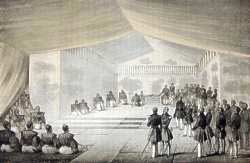 |
Perry and his delegation presenting a letter from the US President
to the Japanese authorities |
In the face of Perry’s demands, the shogunate conducted
a national survey, calling for solutions to the foreign threat. The shogunate
received hundreds of responses, the majority of which, broadly speaking,
represented
either of two conflicting viewpoints.
On one side were those who proposed opening the country to foreigners.
Their opponents advocated preserving the centuries-old policy of exclusionism.
But neither side offered a constructive means for realizing their proposals.
In contrast, the memorial submitted by one unknown samurai was clear,
brilliant, progressive, and included concrete advice for the future of
Japan. In his memorial Kaishu pointed out that Perry had been able to
enter Edo Bay unimpeded only because Japan did not have a navy to defend
itself. He urged the shogunate (the central military power headed by
the Tokugawa Samurai clan that had unified Jan under its power) to recruit
men for a navy. He dared to propose that the military government break
age-old tradition and go beyond birthright to recruit men of ability,
rather than the sons of the social elite and certainly there was nobody
in all of Edo more poignantly aware of this necessity than this impoverished,
brilliant young man from the lower echelons of samurai society.
Kaishu advised that the shogunate lift its ban on the construction of
warships needed for national defense; that it manufacture Western-style
cannon and rifles; that it reform the military according to modern Western
standards, and establish military academies. Pointing out the great technological
advances being achieved in Europe and the Untied States, Kaishu challenged
the narrow-minded traditionalists who opposed the adoption of Western
military technology and systems.
Within the first few years after the arrival of Perry, all of Kaishu’s
proposals were adopted by the shogunate. In January 1855, Kaishu was
recruited into government service. In Japanese chronology this corresponded
to the second year of the Era of Stable Government, to which purpose
Kaishu dedicated the remaining forty-four years of his life. In September,
Kaishu sailed to Nagasaki, as one of a select group of thirty-seven Tokugawa
Tokugawa retainers to study at the new Nagasaki Naval Academy, where
he remained for two and a half years.
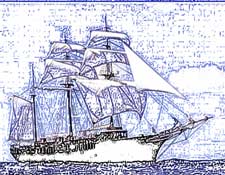 |
An artist’s depiction
of the Karin Maru on the way to San Francisco |
In January 1860 Katsu Kaishu commanded the famed Kanrin Maru, a tiny
triple-masted schooner, on the first authorized overseas voyage in
the history of the Tokugawa Shogunate. Captain Katsu and Company were
bound for San Francisco. They preceded the Japanese delegation dispatched
to Washington aboard the U.S. steam frigate Powhatan to ratify Japan’s
first commercial treaty. After the arrival of the Powhatan, they would
return to Japan to report the safe arrival of the delegation. But more
significantly for Captain Katsu and Company was the opportunity to
demonstrate the maritime skills they had acquired under their Dutch
instructors at Nagasaki, for, “as Kaishu emphasized,” the
glory of the Japanese Navy.
Kaishu remained in San Francisco for nearly two months, observing American
society, culture and technology. He contrasted American society to that
of feudal Japan, where a person was born into one of four castes, “warrior,
peasant, artisan, merchant” and, for the most part, remained in
that caste for life. Of particular interest to Kaishu, who was determined
to modernize and indeed democratize his own nation, were certain aspects
of American democracy. “There is no distinction between soldier,
peasant, artisan or merchant. Any man can be engaged in commerce,” he
observed. “Even a high-ranking officer is free to set up business
once he resigns or retires.”
Generally, the samurai, who received a stipend from their feudal lord,
looked down upon the men of the merchant class, and considered business
for monetary profit a base occupation. “Usually people walking
through town do not wear swords, regardless of whether they are soldiers,
merchants or government officials,” while in Japan it was a samurai’s
strict obligation to be armed at all times. Kaishu also observed the
peculiar relationship between men and women in American society. “A
man accompanied by his wife will always hold her hand as he walks.” The
immense cultural and social gaps notwithstanding, Kaishu, the outsider
among his countrymen, was pleased with the Americans.
“I had not expected the Americans to express such delight at our
arrival to San Francisco, nor for all the people of the city, from the
government officials on down, to make such great efforts to treat us
so
well.”
In 1862, Kaishu was appointed vice-commissioner of the Tokugawa Navy.
He established his naval academy in Kobe in 1863, with the help of his
right-hand man, Sakamoto Ryoma. The following year Kaishu was promoted
to the post of navy commissioner, and received the honorary title Awa-no-Kami,
Protector of the Province of Awa.
In October 1864, Kaishu, who had thus far enjoyed the ear of the shogun,
was recalled to Edo, dismissed from his post and placed under house
arrest for harboring known enemies of the Tokugawa. His naval academy
was closed down, and his generous stipend reduced to a bare minimum.
In 1866 the shogun’s forces suffered a series of humiliating defeats
at the hands of the revolutionary Choshu Army (one of the principle military
domains). Kaishu was subsequently reinstated to his former post by Tokugawa
Yoshinobu, Head of the House of Tokugawa, who in the following December
would become the fifteenth and last Tokugawa Shogun. Lord Yoshinobu did
not like Kaishu, just as Kaishu did not like Lord Yoshinobu.
Kaishu was a maverick within the government, who had broken age-old
tradition and even law by imparting his expertise to enemies of the shogunate;
who openly criticized his less talented colleagues at Edo for their inability,
if not blind refusal, to realize that the years, and perhaps even days,
of Tokugawa rule were numbered; who in the Grand Hall at Edo Castle had
braved punishment and even death by advising then-Shogun Tokugawa Iemochi
to abdicate; and who was now recalled to service because Yoshinobu and
his aides knew that Kaishu was the only man in all of Edo who wielded
both the respect and trust of the revolutionaries.
In August 1866, Navy Commissioner Katsu Kaishu was dispatched to Miyajima “Island
of the Shrine” in the domain of Hiroshima to meet representatives
of Choshu. Before departing he told Lord Yoshinobu, “I have things
settled with the Choshu men within one month. If I’m not back by
then, you can assume that they’ve cut off my head.”
Kaishu was aware of the grave danger to his life as an emissary of the
Tokugawa, but nevertheless traveled alone, without a single bodyguard.
Shortly after successfully negotiating a peace with Choshu, the outsider
resigned his post, due to irreconcilable differences with the powers
that were, and returned to his home in Edo.
In October 1867, Shogun Tokugawa Yoshinobu announced his abdication
and the restoration of power to the emperor. But diehard oppositionists
within the Tokugawa camp were determined to fight the forces of the new
imperial government. The leaders of the new imperial government were
equally determined to annihilate the remnants of the Tokugawa, to ensure
that it would never rise again.
Civil war broke out near Kyoto in January 1868. Although the imperial
forces, led by Saigo Kichinosuke of Satsuma, were greatly outnumbered,
they routed the army of the former shogun in just three days. The new
government’s leaders now demanded that Yoshinobu commit ritual
suicide, and set March 15 as the date fifty thousand imperial troops
would lay siege to Edo Castle, and, in so doing, subject the entire city
to the flames of war.
The services of Katsu Kaishu were once again indispensable to the Tokugawa.
Kaishu desperately wanted to avoid a civil war, which he feared would
incite foreign aggression. But he was nevertheless bound by his duty
as a direct retainer of the Tokugawa to serve in the best interest of
his liege lord, Tokugawa Yoshinobu. In March 1868, with a formidable
fleet of twelve warships at his disposal, this son of a petty samurai
was the most powerful man in Edo. And as head of the Tokugawa army, he
was determined to burn Edo Castle rather than relinquish it in battle,
and to wage a bloody civil war against Saigo’s forces.
When Kaishu was informed of the imperial government’s plans for
imminent attack, he immediately sent a letter to Saigo. In this letter
Kaishu wrote that the retainers of the Tokugawa were an inseparable part
of the new Japanese nation. Instead of fighting with one another, those
of the new government and the old must cooperate in order to deal with
the very real threat of the foreign powers, whose legations in Japan
anxiously watched the great revolution, which had consumed the Japanese
nation for these past fifteen years.
Saigo replied with a set of conditions, including the peaceful surrender
of Edo Castle, which must be met if the House of Tokugawa was to be allowed
to survive, Yoshinobu’s life spared, and war avoided. At an historic
meeting with Saigo on March 14, one day before the planned attack, Kaishu
accepted Saigo’s conditions, and went down in history as the man
who not only saved the lives and property of Edo’s one million
inhabitants, but also the entire Japanese nation.
This article was posted
with permission from the author.
©2002 Romulus Hillsborough
This article originally appeared in the Summer 2002 issue of Tokyo
Journal.
Acknowledgements:
Permission to use the photo of Katsu Kaishu was provided by Takaaki
Ishiguro, a photo collector currently living Tokyo.
The image of Perry’s delegation presenting a Presidential letter
to the Japanese authorities is from a collection of sepia toned stone
lithograph plates from the original “Narrative Of An Expedition
Of An American Squadron To The China Seas And Japan” provided complements
of Kauai Fine Arts located in Lawai, Hawaii.
About the Author:
Romulus Hillsborough is a native Californian who lived in Japan for
sixteen years, studying the language, history and culture. He is the
author of RYOMA - Life of a Renaissance Samurai(Ridgeback Press, 1999)
and Samurai Sketches: From the Bloody Final Years of the Shogun (Ridgeback
Press, 2001). RYOMA is the only biographical novel of Sakamoto Ryoma
in the English language. Samurai Sketches is a collection of historical
sketches, never before presented in English, depicting men and events
during the revolutionary years of mid-19th century Japan. Reviews and
more information about these books are available from Ridgeback
Press.
For more information about Katsu Kaishu and Sakomoto Ryoma see:
“Ryoma - Life of a Renaissance Samurai”
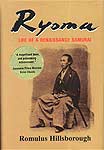
By Romulus Hillsborough
Ridgeback Press
Hardcover, 614 Pages
RBP-B- 2035
$40.00
(Plus $6.00 Shipping Within US)

|